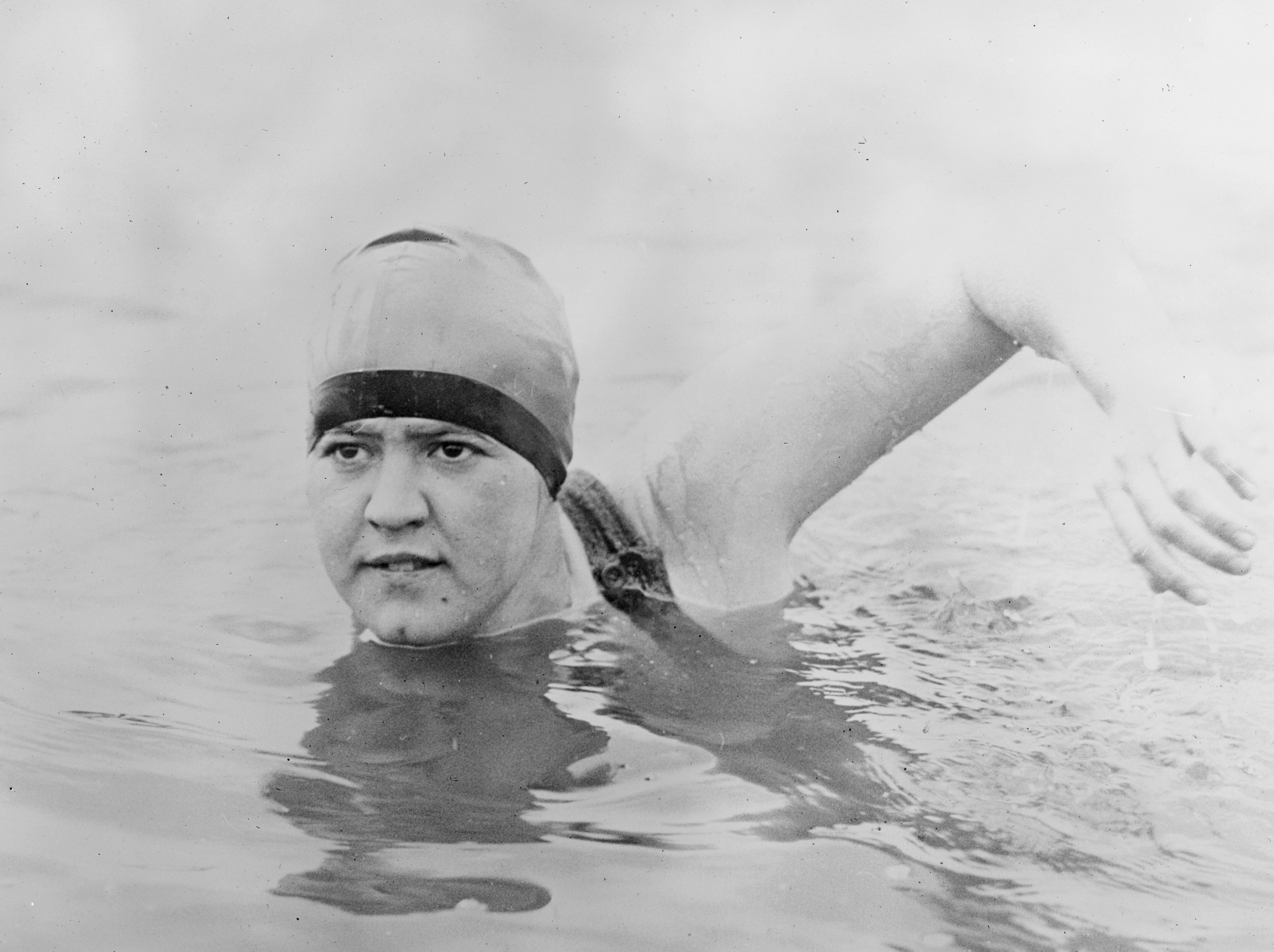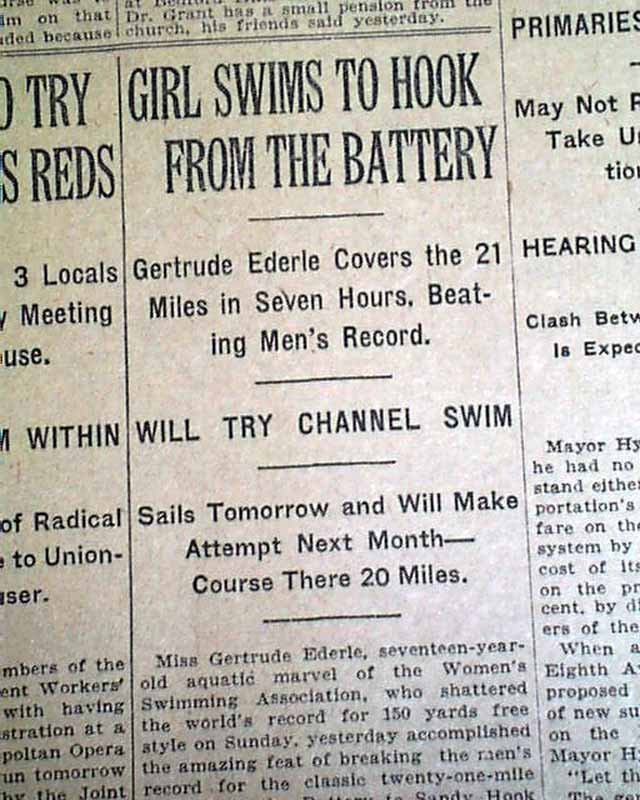GERTRUDE EDERLE, QUEEN OF THE WAVES
ENGLISH CHANNEL — AUGUST 1925 — Ahead lie the white cliffs of Dover. Behind are a dozen numbing hours of churning the waves. She knows she can make it. She just needs a rest so she floats — face down.
A shout comes from the trailing tugboat. “She’s drowning!” A man jumps in. When he grabs her, she is disqualified. Furious, she stands on deck, wondering “What will they think of me back in the States?”
In the early 20th century, the English Channel was the swimmer’s supreme test. The 21 miles from Dover to Calais seemed possible, but icy water, winds, and waves defeated swimmer after swimmer. Nearly 100 men tried, just five succeeded. And women?
“The torments of seasickness, indigestion, inflammation of the eyes, great cold and other disagreeable features may prove too much for any woman swimmer,” said a Scotsman who had failed 21 times.
But it was the 1920s and women were bobbing their hair! Shortening skirts! Smoking! So when 19-year-old Gertrude Ederle vowed to swim the channel, America watched her as it would soon watch Lindbergh.
The public called her “Trudy” but to her family she was “Gertie.” Learned to swim at five and became “a water baby.” Set her first national freestyle record at 12, and by 1925, she held 30 U.S. and world marks. But pools were boring. Gertie felt more at home in the sea.
“To me, the sea is like a person — like a child that I’ve known a long time. When I swim in the sea, I talk to it. I never feel alone out there.”
The public watched Trudy in the 1924 Olympics, where a bum knee limited her to one gold and two bronzes. She seemed invincible, the “queen of the waves,” but no one knew that each swim brought huge risk.
With her hearing damaged by childhood measles, doctors warned that swimming could leave her deaf. “But I loved the water so much, I just couldn't stop.” So she swam on, setting her sites on the channel.
To warm up, Ederle swam from Manhattan to Sandy Hook on the Jersey Shore — 21 miles in seven hours, a time that stood for 80 years. She was ready. Pulled from the water on her first attempt, this time she brought her father along, with strict instructions: “Don’t let anyone take me out of the water unless I ask.”
All that summer, newspapers reported from France where Trudy and four other women were training for the channel swim. Baltimore’s Lillian Cannon, a flapper with bobbed hair, posed in her bathing suit. Clarabelle Barrett, a 6’3” teacher, seemed a tougher rival. But the weather stayed gray and chilly.
Finally on August 2, Barrett entered the water at Cape Gris-Nez. Twenty-two hours brought her within sight of white cliffs, but the last mile, with breakers and riptides, was always the toughest. The exhausted teacher gave up. Trudy’s turn.
At 7:08 a.m. on August 6, 1926, wearing a dragless suit of her own design, her limbs coated in sheep’s grease for warmth, Gertrude Ederle stepped onto the beach. A flapping red flag warned of choppy waters. “Please God, help me,” she thought, and dove in.
For the first hour, she did not talk to the sea; she sang. “Let Me Call You Sweetheart” guided her into open waters. Reporters alongside marveled at her power, but by noon the weather turned. When winds whipped the waves, her coach ordered her out. Henry Ederle intervened. No one was to touch Gertie.
“Gertie,” her coach yelled. “You must come out!'” She lifted her head above choppy waters.
“What for?” She swam on.
At dusk, hundreds gathered on the British beach. At 8:45 p.m. some spotted her red swim cap offshore. Just 600 yards remained, but that final stretch took another hour. When she stumbled onto the beach, crowds surrounded her. An immigration official asked for her passport. Few could believe her time.
The fastest channel swim had taken 16 hours, 33 minutes. Gertrude Ederle swam a winding 30 miles in 14 hours, 34 minutes. A woman had broken a man’s record — by two hours!
“When Gertrude Ederle struck out from France,” an American paper wrote, “she left behind her a world which has believed for a great many centuries that woman is the weaker vessel. It may be that she will turn out to be an even greater discoverer than Columbus. It was only a continent which he found.”
Back home, she rode waves of publicity. A ticker tape parade, two million shouting “Trudy! Trudy!” A Hollywood movie and vaudeville tour. Meeting President Coolidge who called her “America’s Best Girl.” But then the years caught up.
Doctors had been right. Swimming left her nearly deaf. When the publicity faded, she lived quietly, teaching deaf children to swim. Her channel record stood until 1950, and by then channel swimming had lost its magic. But long distance swimmers remember.
Each summer in Manhattan, the annual Ederle Swim sees dozens set out from Battery Park towards New Jersey. Last year, Disney released “Young Woman and the Sea,” about her amazing swim.
In 2000, a reporter tracked down 95-year-old Gertrude Ederle at a New Jersey nursing home. When the reporter asked “why” she answered in a voice as soft as a breeze. “I wanted to prove it could be done. It took a Yankee to show them how.”














